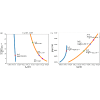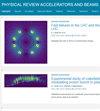3D small-gain formula allowing strong focusing and harmonic lasing for a ring-based x-ray free electron laser oscillator
IF 1.8
3区 物理与天体物理
Q3 PHYSICS, NUCLEAR
Physical Review Accelerators and Beams
Pub Date : 2024-06-21
DOI:10.1103/physrevaccelbeams.27.060702
引用次数: 0
Abstract
We present a detailed derivation of a formula for the small-gain calculation for an x-ray free electron laser oscillator (XFELO) based on a medium-energy (3–4 GeV) storage ring. We found harmonic lasing and strong focusing are essential for this beam energy range. Taking the small-signal low-gain formula developed by Kim and his colleagues, we modified it in such a way that the gain can be calculated without the “no focusing approximation,” and a strong focusing can be applied, as well as harmonic lasing. In this formula, the gain is represented as a product of two factors with one of them depending only on the harmonic number, undulator period, and gap. Using this factor, we show that it is favorable to use harmonic lasing to achieve hard x-ray FEL working in the small-signal low-gain regime with the medium-energy electron beam. Our formula also allows FEL optimization by varying the vertical gradient of the undulator, the vertical dispersion, and the horizontal and vertical focusing, independently. As an example, we applied this formula to study the feasibility of an XFELO option for the National Synchrotron Light Source II (NSLS-II) upgrade. Since a quite high peak current is required for the FEL, collective effects of beam dynamics in medium-energy synchrotrons significantly affect the electron beam parameters. We carried out a multiparameter optimization taking collective effects into account. Note, even though our example is for a ring-based XFELO at 3 to 4 GeV, the formula and, in particular, the approach developed here may be applied to other types of FELs.

三维小增益公式允许环形 X 射线自由电子激光振荡器实现强聚焦和谐波激光
我们详细推导了基于中等能量(3-4 GeV)存储环的 X 射线自由电子激光振荡器(XFELO)的小增益计算公式。我们发现谐波激光和强聚焦对这一光束能量范围至关重要。利用 Kim 及其同事开发的小信号低增益公式,我们对其进行了修改,使其在计算增益时可以不使用 "无聚焦近似",并且可以应用强聚焦以及谐波激光。在这个公式中,增益表示为两个系数的乘积,其中一个系数只取决于谐波数、起伏周期和间隙。利用这个系数,我们证明了利用谐波激光实现硬 X 射线 FEL 在小信号低增益状态下与中等能量电子束一起工作是有利的。我们的计算公式还允许通过独立改变减压器的垂直梯度、垂直色散以及水平和垂直聚焦来优化 FEL。举例来说,我们应用该公式研究了美国国家同步辐射光源二期(NSLS-II)升级的 XFELO 方案的可行性。由于 FEL 需要相当高的峰值电流,因此中能同步加速器中光束动态的集体效应会对电子束参数产生重大影响。考虑到集体效应,我们进行了多参数优化。需要注意的是,尽管我们的例子是基于环的 3 至 4 GeV XFELO,但该公式,尤其是此处开发的方法可用于其他类型的 FEL。
本文章由计算机程序翻译,如有差异,请以英文原文为准。
求助全文
约1分钟内获得全文
求助全文
来源期刊

Physical Review Accelerators and Beams
Physics and Astronomy-Surfaces and Interfaces
CiteScore
3.90
自引率
23.50%
发文量
158
审稿时长
23 weeks
期刊介绍:
Physical Review Special Topics - Accelerators and Beams (PRST-AB) is a peer-reviewed, purely electronic journal, distributed without charge to readers and funded by sponsors from national and international laboratories and other partners. The articles are published by the American Physical Society under the terms of the Creative Commons Attribution 3.0 License.
It covers the full range of accelerator science and technology; subsystem and component technologies; beam dynamics; accelerator applications; and design, operation, and improvement of accelerators used in science and industry. This includes accelerators for high-energy and nuclear physics, synchrotron-radiation production, spallation neutron sources, medical therapy, and intense-beam applications.
 求助内容:
求助内容: 应助结果提醒方式:
应助结果提醒方式:


